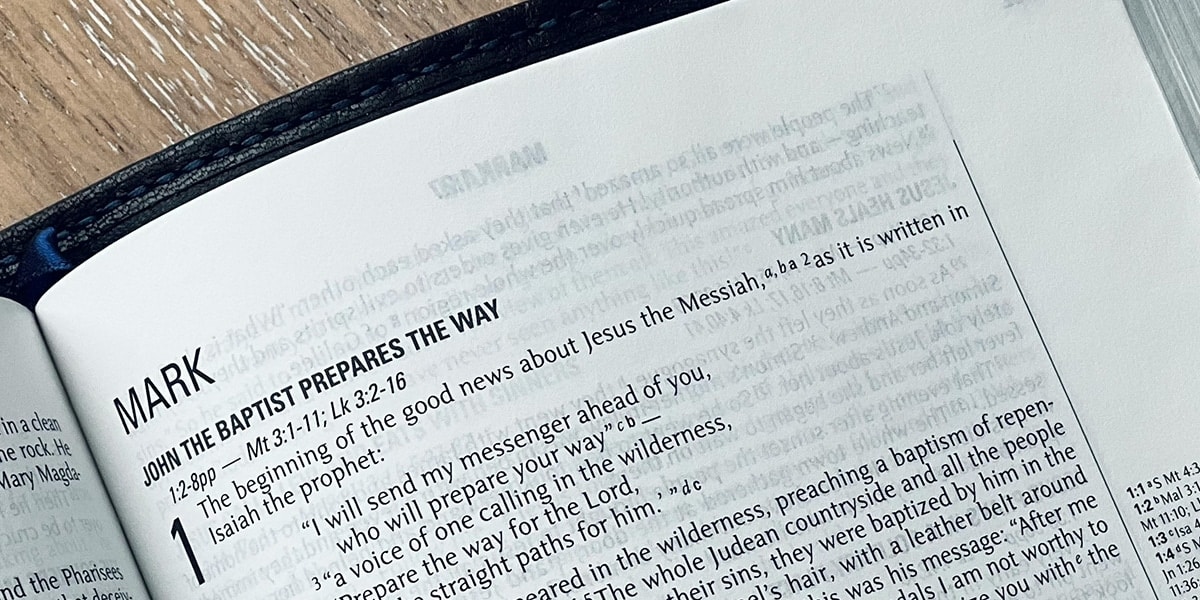Scholars have referred to Mark’s Gospel as a passion narrative with a few introductory texts. But more to the point, it is better described as a primer on conversion.
Once upon a time there was a king who heard the message of an itinerant holy man and was struck to the heart. Immediately the king gave up his throne, his power and possessions, and begged to become the man’s disciple. The master said the king would find it extremely hard to be a worthy disciple, because of his former position and because he must undergo a harsh apprenticeship, obeying the master without question.
The king pledged his obedience and life to the master. He was assigned to collect and empty the slop buckets, humiliating for a former king. But he performed his task diligently.
Weeks went by, and the other disciples grew uncomfortable with the way the master was ignoring the new disciple. They came to him saying: “Is the king ready yet to be one of us?” Finally, the master sent his number-one disciple to test the king’s readiness. The master told the head disciple to spill the contents of the slop buckets over the floor the king had just washed. He was to watch the king-disciple’s reaction and report back.
When the buckets were dumped, the king was livid. He turned on the disciple in rage, telling him that he was lucky. If the king were still the king, he’d have had him severely punished for his actions. When the disciple reported this, the master shook his head saying, “As I thought, he’s not ready yet.”
When the former king was tested next, he held his tongue, but his face grew red and his eyes glared. The third time, the king controlled his words and his face, but looked rigidly at the floor, struggling. When this was reported, the master knew the king was getting close.
More weeks went by, and the disciples were feeling that the master was being far too hard on someone who had once been king and yet had done so much to change. The head disciple asked to test the king again. “Please,” he said, “I think this time he will be ready.” The head disciple was given permission. This time the king-disciple did not react with anger, but merely looked the head disciple in the eye with gentleness and bowed before him. Then the king-disciple began to clean up the floor.
But the head disciple wanted to make sure. And so as the former king bent over his task, the head disciple kicked the bucket a second time. Again, the king-disciple straightened up, bowed low and went about his work. Elated, the head disciple ran to his master and excitedly told him that, yes, the king was ready to join the other disciples.
The master listened and said, “You are right. The king is now ready. He has become a disciple.”
As the head disciple turned to leave, his master’s words brought him up short. “Wait! When you go to tell him and bring him here, you must take his place.” The disciple was stunned and asked why. “Because you did not obey me. You tested him as I instructed you and then you did something on your own that was not necessary. It is time you learned obedience once again, and he will take your place as my head disciple.”
The man obeyed, chastened, seething with bitterness and confusion. The king had become a true disciple, ready to begin his new life, but the other was just beginning to learn what it means to listen, to obey, to follow the master and to know what being a true disciple might entail.
Is the king ready yet? Are we?
Discipleship Continually Refashions Us
This story is a paradigm for Mark’s Gospel. We are called again and again to learn—often the hard way—what following in the footsteps of the crucified and risen beloved Son of God might mean.
Just when we think we know, there is something to face that we never expected and did not take into account. There is the call to discipleship and to catch people in the net of the Kingdom; the call to deny one’s very self and take up the cross that is laid on us by our sharing the truth and sufferings on behalf of justice; and there is the call to community in the Resurrection.
It never ends. It is a circle that comes back around, spiraling in and down as it reforms and refashions us in the image of the beloved Child of God.
“The gospel of Jesus Christ [the Son of God]” (Mark 1:1—all quotes are New American Bible unless indicated otherwise). This is the way the first Gospel begins: blunt, abrupt, as though it were an interruption to history, to thought patterns and to all of life. And then immediately it jumps backward in time to the Prophet Isaiah and forward to John the Baptizer and to the “one mightier than I,” who “will baptize you with the holy Spirit” (Mark 1:7-8).
This is a tradition of prophetic discipleship. Before the first chapter is complete, Jesus will have continued in this vein and called his own to come after him, patterning their lives—and our own—on his way. We begin immediately with the first call to discipleship in the Gospel: the call to “Come after me, and I will make you fishers of men” (1:17)—the call to catch men and women for the Kingdom of God. And Peter, along with Andrew, James and John, turns Jesus’ way and goes off in his company.
The journey to Jerusalem, the place of reckoning for all prophets, begins with this first step, the initial call to discipleship. And for the next seven chapters Jesus will gather more into his company and teach them in word, parable, healings, associations with the poor, the outcast, the leper and the sinner, and by feeding them with bread, insight and hope.
There are only 16 chapters in Mark, and there is an immediacy that is relentless, building in intensity and demanding our response. We come along with them, wrestling with the words and presence of God in Jesus, seeking to know the truth of who this man really is who calls us out. In the words of Simone Weil in Waiting for God, it is hard to sift through our lives to the actual truth of the person of Jesus.
In the past, scholars have referred to Mark’s Gospel as a passion narrative with a few introductory texts. But more to the point, it is better described as a primer on conversion, a summons to discipleship. This discipleship is fathoms deep—with each call drawing us further and further into waters that are mysterious, fearful and wondrous.
Question of Jesus’ Identity Central
Eugene La Verdiere’s two-volume commentary on Mark (Liturgical Press) divides the text in half: Chapters 1 through 7 and Chapters 8 through 16. The turning point is Jesus’ probing question, “Who do people say that I am?” (Mark 8:27), after he has fed the 4,000 and warned his disciples about the leaven of the Pharisees.
When Peter seems to know the answer and is quick to respond with “You are the Messiah!” (Mark 8:29), he is ordered not to repeat that to anyone. Peter has his own ideas on who Jesus is and who he wants Jesus to be. In reality, Jesus will not fulfill any of Peter’s hopes. Instead, Peter will have to learn through the hard experience of failure, dismay and betrayal that this man is far beyond anything he imagined.
To the Jews, messiah often meant a political or nationalistic savior who would put the Jewish nation back on the map and free them from their oppressors. That concept not only limited who Jesus might be, but also emphasized aspects of liberation and freedom that were not helpful in coming to know Jesus’ true identity.
The fledging disciple, Peter, is ordered brusquely not to spread this erroneous idea. And Peter is caught up sharply and confused, as all of us must eventually learn in our singular and often skewed relationship to Jesus.
And then Jesus presents the heart of his message: the first teaching on how “the Son of Man must suffer greatly and be rejected by the elders, the chief priests, and the scribes, and be killed, and rise after three days” (Mark 8:31). Peter vigorously argues with Jesus, resisting this teaching with every fiber of his body and soul.
This confrontation is incisive, splitting the two halves of the Gospel into who readers might have thought this man was and who he believes himself to be, insisting that we look squarely at the truth and not be mired in our own wants and intentions.
Peter begins to reject and resist at this midpoint. By the time he vehemently denies Jesus three times in Chapter 14 (verses 66-72), we shouldn’t be so taken off guard, wondering how he could have done that—he’d begun to fashion his own way of being Jesus’ disciple long before he was questioned in the high priest’s courtyard by a serving girl and a stranger.

The Demands of the Cross
Peter stumbles over the second call to discipleship: the summons to the cross, which is the stumbling block for all disciples.
Jesus said to the crowd with his disciples: “If any want to become my followers, let them deny themselves and take up their cross and follow me. For those who want to save their life will lose it, and those who lose their life for my sake, and for the sake of the gospel, will save it. For what does it profit them to gain the whole world and forfeit their life? Indeed, what can they give in return for their life? Those who are ashamed of me and of my words in this adulterous and sinful generation, of them the Son of Man will also be ashamed when he comes in the glory of his Father and the holy angels” (Mark 8:34-38, New Revised Standard Version).
This chapter and Jesus’ words act as a hinge between the halves of Mark’s Gospel, a door that can either open to the possibility, fraught with the danger and demands of the cross, or close off the mysterious grace-filled way of Jesus’ revelation of himself as the beloved child and suffering servant of his Father. That revelation began at his baptism in the opening chapter.
Each step of the way opens to awareness and vulnerability, yet also presents a temptation to remake Jesus and his message and meaning into our own design that suits our own ends. It is far easier to ignore the Gospel’s hard words and warnings that Jesus consistently shares with disciple-friends who are afraid at what he might be saying, especially his suggesting that they might have to suffer and share death with him.
Call to Be Different
In Mark’s last eight chapters we hear Jesus’ teaching on how his disciples should act among themselves and how they are to differ radically from other groups in their society and culture. They are to guard against ambition and envy of anyone’s position of power, always living as servants, intent on one another’s needs, especially attentive to those in most misery or need. Jesus’ disciples are to shun riches as a danger and instead give what they have to the poor, laying up “treasure in heaven; then come, follow me” (Mark 10:21b).
They are reminded three times of the cross that looms before them, their own blindness and pettiness that cause dissension among them. Again disciples are to be characterized by being servants. “Whoever wishes to be first among you will be the slave of all. For the Son of Man did not come to be served but to serve and to give his life as a ransom for many” (Mark 10:43-45).
True discipleship is imaged in unlikely people: children, those without any power in society, the poor, those who struggle to live with dignity, Peter’s mother-in-law who immediately rises from her sickbed to wait on Jesus, a woman who reaches out to touch just the hem of his garment, a widow who gives a copper coin not worth a cent but gives out of her sustenance all she has to live on. All these people image Jesus, who will give his very life.
And there is a foreigner, a Syrophoenician woman who humbles herself before Jesus, begging on behalf of her daughter, surprising Jesus with her quick repartee and at the same time suggesting that he may belong to others besides the sheep of the house of Israel—perhaps he belongs to anyone in need, who is humble enough to acknowledge who he is as the beloved of God.
Another woman anoints him, publicly and ritually, with oil poured upon his head in the tradition of the priest, prophet and king. She will be remembered for her action, her alliance with him, her witness to his presence and power.
The 12 disciples who accompany Jesus keep missing the other disciples whom Jesus keeps pointing out and praising as those who believe, those who know him and those who are truly already “in his company.”
The Resurrection Challenge
The third and last call to discipleship is in the last chapter on the resurrection. After the terrible reality of Jesus’ rejection, brutalization and crucifixion, and the burial, there is only an empty tomb and the message that the disciples are to return to Galilee. There they will see him. After hearing this, the three women “fled from the tomb, seized with trembling and bewilderment. They said nothing to anyone, for they were afraid” (Mark 16:8).
Many people think this is the original ending of Mark. It falls like a stone, sinking into the sea. Is that all there is?
But that is the beauty and the ingeniousness of the text. In their fear, the three women do go to the other disciples (all those in the city for the feast, all those who traveled in his company from Galilee, and the disciples—perhaps 30-70 people).
And they go home to Galilee, a journey of 90 miles, traveling together for a week or more. We can imagine them, walking and talking their way through their bewilderment and fear. They probably share the stories and the memories of their master, their teacher, healer, companion who fed them, warned them and suffered so terribly yet strangely. They marvel that somehow he could be still alive and waiting for them.
This is the call to discipleship in the Resurrection: to walk in community, sharing the gospel with the other disciples, walking and talking through our fear and looking for him out in the world.
The disciples return to Galilee, and when we return to the beginning of the Gospel, we find that in that first chapter (perhaps we missed it before) after Jesus’ baptism, “After John had been arrested. Jesus came to Galilee proclaiming the gospel of God: ‘This is the time of fulfillment. The kingdom of God is at hand. Repent, and believe in the gospel’” (Mark 1:14-15).
He appeared in Galilee and we, like the disciples, are to make our way through the Gospel again and again, in light of the cross and the resurrection. We catch what we missed before: that this Jesus is in the tradition of Isaiah, the suffering servant, John beheaded and Jesus crucified, and that we too must walk in that way, picking up our cross and coming after him, part of his company of friends, learning and relearning what it means to follow Jesus Christ, the Son of Man, the Son of God made flesh among us.
In the Beloved Son’s Company
We go around again in the paschal year’s mystery, in the Gospel readings, in our lives and times, in history and the sacramental rituals, sharing our knowledge and growing in the mystery of discipleship and wisdom of being in this beloved Son of God’s company. Company here means those who break bread together—the bread of the Scriptures, the bread of the Eucharist and our bread, our money and our resources shared among those in greatest need.
Mark’s Gospel is so densely packed, so rich in layers and unfathomable except in community. Historically, it is more than 30 years after the crucifixion and resurrection of Jesus. Some scholars think it is a struggling community being pressured by the Jewish community to fight with them against the Romans to protect the Temple in Jerusalem.
And Mark writes to exhort his small band of followers to remember the Temple is now the Body of Christ, the Way of the Cross is the way of nonviolent resistance to evil, and No! they are not to fight the Romans. Instead, they are to pick up their cross and walk in the way of service, never killing in the name of the Father or his beloved Son.
And yes, this is our calling, our summons and our saving grace in this year of Mark’s Good News.
Why would this God of ours summon us to be disciples of his beloved Son? In the words of a Sufi master: “I chose to call you because you need it more than the others!”
Mark’s Gospel calls us, as community and Church who need it more than others, and who are so reluctant and slow to put out into the deep of discipleship. Once again in this year we tread the circle of the Good News of God in the world, circling home through the heart of this beloved Son, home with all the Father’s children. As we go we learn a new step or two in the Spirit’s way of dancing home, around and around and around. Amen.









1 thought on “Mark: The Gospel of Conversion”
Pingback: Saint Mark – Saint Gregory the Great Catholic Church